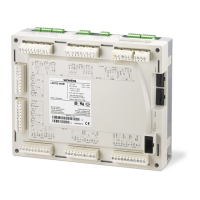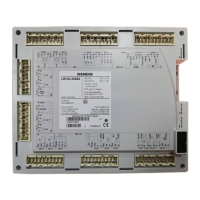36/301
Siemens Building Technologies Basic Documentation LMV5... CC1P7550en
HVAC Products 4 Burner control 13.08.2004
No-load voltage at terminal ION (X10–03, terminal 1) approx. U
Mains
Note: The ionization probe must be installed such that protection against electric shock
hazard is ensured!
Short-circuit current max. AC 0.5 mA
Minimum detector current required DC 6 µA, display flame approx. 50 %
Maximum detector current approx. DC 85 µA, display flame approx. 100 %
Permissible length of detector cable
(lay separately) 100 m (wire-earth 100 pF / m)
The greater the detector cable capacitance (cable length), the lower the voltage at the
ionizations probe and, therefore, the lower the detector current. In the case of extensive
cable lengths and high-resistance flames, it may be necessary to use low-capacitance
cables (e.g. ignition cable).
The electronic circuit is designed such that impacts of the ignition spark on the ioniza-
tion current will be largely eliminated. Nevertheless, it must be ensured that the mini-
mum detector current required will already be reached during the ignition phase.
If that is not the case, the connections of the ignition transformer on the primary side
must be changed and / or the location of the electrodes also.
No-load voltage at the QRB... terminal (X10–02, terminal 1) approx. DC 8 V
Minimum detector current required
(with flame) DC 30 µA, display flame 35 %
Maximum permissible detector current
(dark current with no flame) DC 5 µA
Maximum detector current approx. DC 70 µA, display flame approx. 100 %
Permissible length of QRB... detector cable
(lay separately) 100 m (wire-wire 100 pF / m)
A detector resistance value of RF < approx. 5 kΩ is identified as a short-circuit and, in
operation, will lead to safety shutdown as if loss of flame had occurred.
Measurement of the voltage at terminal QRB... during burner operation gives a clear
indication: If voltage drops below 1 V, safety shutdown will probably occur.
For that reason, before using a highly sensitive photoresistive flame detector (QRB1B
or QRB3S), it should be checked whether such a detector is really required!
Increasing line capacitance between the QRB... terminal and mains live «L» adversely
affects the sensitivity and increases the risk of damaged flame detectors due to mains
overvoltages.
Separate routing of detector cables as specified in Data Sheet 7714 must be observed.
For indication of flame (on the AZL5...), observe the following general rules:
The above percentage values are obtained when, for parameter «Standardize» (stan-
dardization of flame signal), the default setting is used.
The accuracy of the display is a maximum of ± 10 %, depending on the tolerances of
the components.
It should also be noted that, for physical reasons, there is no linear relationship be-
tween the display and the detector signal values. This is especially obvious with ioniza-
tion current supervision.
For more detailed information, refer to Data Sheet N7714.
IONIZATION (suited for
continuous operation)
Note
QRB... (for intermittent
operation only)
Notes

